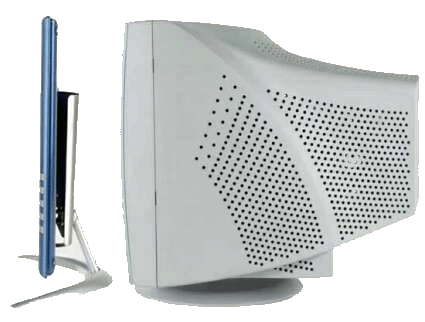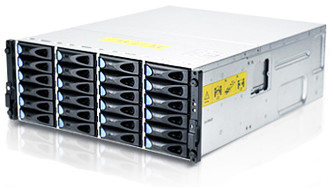Archive for April, 2009
The Myth about Monitor Refresh Rates and Fatigue

There seems to be some misconception around the issues related to eyestrain and fatigue when using computer monitors and staring at computer screens for great lengths of time. I spend no less than thousands of hours staring at computer screens a year at home, work and elsewhere.
My office desk has 4 monitors set up in a panorama format, I have 3 laptops at home that I use, and 2 large 26″ LCD montors in my home office, as well as my phone, PDA, PSP, and my daughter’s DVD player, Leapster 2 and other devices. I’m surrounded by screens and monitors all day long.
But these are not CRT monitors, and there’s a reason for that.
Back when CRT monitors were all there was, these monitors refreshed at a rate of roughly 60Hz, which… coincidentally, was also the same refresh rate of the standard fluorescent tube that are used in almost every office environment. To reduce eyestrain, you could:
- Buy a monitor with a higher refresh rate (or set your monitor for a higher rate through software), or…
- Switch to a non-CRT monitor such as an LCD monitor or a projector, or…
- Change the fluorescent ballasts you’re using to other lighting which do not happen to refresh at 60Hz such as one of the newer solid-state ballasts (which operate at 25,000Hz instead of 60Hz) or full-spectrum bulbs instead, or…
- Just ignore the problem and hope it goes away, along with your eyes and headaches.
There are quite a lot of negative side-effects of using the standard 60Hz fluorescent ballasts, such as:
- The ballasts operate at 60Hz, or cycles per second – the same frequency of the AC voltage they run on. This means that each lamp switches on and off at 120 times per second, resulting in a barely perceptible flicker and a noticeable hum (sounding like a buzzing low ‘A’ note on a piano). About 25% of the population is sensitive to ballast flicker and hum and actually can become physically ill, with symptoms such as headaches, nausea, itching and burning eyes, tension, eye fatigue, and general fatigue.
- Operating at 60Hz, they may cause a stroboscopic effect with any machinery which has parts, such as pulleys or gears, running at speeds that are a multiple of 60Hz. The stroboscopic effect will cause the machine to appear motionless, which could be a deadly hazard.
- The most commonly used electro-magnetic ballast, the rapid-start type, draws 2-3 watts even if the lamp’s tubes have been removed, a practice often employed by businesses to reduce excessive light levels. This could be a sizable expense in a building with many lamps.
- They give off excessive EMF (Electro-Magnetic Fields), considered a potential cancer-causing agent.
- Any of the electro-magnetic ballasts produced prior to 1978 contain PCB’s – a known carcinogen.
- Not energy-efficient, with a relatively short life span of about 10 years.
- During the final 30% of their lifespan they consume the same amount of energy, while producing far lower light levels.
I switched over to full-spectrum bulbs and CFL bulbs a few years back, so I don’t see these issues, but I also no longer use a CRT monitor.
Here’s the confusing bit: LCD monitors don’t have the same refresh rate issues. People bring this up year after year, and it was raised on a mailing list I participate in, in the context of eyestrain with using ebook readers on mobile devices (Palm, Kindle, etc.). A lot of people on that list suggested that the person should change their refresh rate on their LCD, so it doesn’t cause eyestrain.
Let me restate: Changing refresh rates on LCD monitors does nothing to help or alleviate eyestrain. In fact, it does nothing at all.
The “flicker” that you get when using a standard CRT monitor + fluorescent bulbs is the a result of phosphor decay; that is, after the energy from the electron gun is transferred to the phosphor material, the energy and the resulting light begin to decay very slowly until the electron beam hits the phosphor again. …
From the IEEE Xplore page:
“…the decay-time constant of an image tube phosphor is a complex function of many variables: chemical, electrical, and mechanical. One variable often overlooked in image tube applications is that of excitation time. This letter presents the excitation-time/decay-time characteristics of some common phosphors and their application to some display problems.”
Since the standard LCD monitors we use today do not employ phosphors in their construction at all, the issue of “refresh rate” is completely irrelevant. The transistors used in the LCD remain open or closed as needed until the image changes.
This tends to be confusing because most graphics cards still “ask for†a refresh rate setting in their configuration. Windows still allows you to change the refresh rate of their graphics drivers, but this is entirely due to the analog nature of existing graphic cards and their legacy support for CRT displays as output devices. While refresh rates do not apply to LCD monitors, most LCDs are set up to accept any settings from 60Hz and above.
So if you’re concerned about eyestrain, headaches or other things and might believe it has to do with your LCD monitor, it probably doesn’t. To alleviate that strain, you could try any of these approaches:
- Put in full-spectrum bulbs to brighten up the lighting in your environment (less strain on your eyes to see in darker work environments)
- Use “task lighting” closer to your direct work surface
- Go outside and step away from your computer monitor for a few minutes every few hours. Stretch, walk around, look at things far and things near, and get your eyes away from being used to focusing at everything 18″-24″ away from you.
- Make sure your monitor is the correct height for your eyes to see it. Too far below, and you’ll hunch over. Too high up and you’ll strain your neck and eyes to see it. Proper workstation ergonomics are critical to reducing eye, neck, shoulder and back strain.
Using these ideas should reduce or remove any possible eyestrain, headaches and other pain you might feel when you’re spending hours and hours every day in front of a computer screen.
Snapshot backups of EVERYTHING using rsync (including Windows!)
Tags: Backups, FreeBSD, linux, Perl, rsnapshot, rsync, servers, sync, Windows Let me just start by saying that I have a lot of data. In multiple places. Some on laptops, some on servers, some on removable drives and mirrored hard disks sitting in a bank vault (yes, really). Lots of data on lots of systems in different states and locations: client data, personal data, work data, community data and lots more.
Let me just start by saying that I have a lot of data. In multiple places. Some on laptops, some on servers, some on removable drives and mirrored hard disks sitting in a bank vault (yes, really). Lots of data on lots of systems in different states and locations: client data, personal data, work data, community data and lots more.
Over the years, I’ve tried my best to unify where that data is sourced from, for example by relocating the standard “My Documents” location on all of my Windows machines (physical and virtual), to point to a Samba share that is served up by a GELI-encrypted volume on my FreeBSD or Linux servers. That part works well, so far, but that’s only a small piece of the larger puzzle.
Over the last decade, the amount of data I’m holding and responsible for managing has grown significantly, and I needed a better way to manage it all.
There are plenty of backup solutions for Linux including the popular Amanda and Bacula, but I needed something more portable, leaner and much more efficient. That quest led me to look to find Unison mostly due to it’s cross-platform support, but it was still a bit more complicated than I needed.
So I kept looking and eventually found rsnapshot, a Perl-based tool wrapped around the standard rsync utility written by Andrew Tridgell.
Since I’d already been using rsync quite a bit over the last 10 years or so to copy data around as I needed it and to perform nightly full backups of my remote servers, I decided to look into using rsync to manage a new backup solution based around incremental backups as well as full backups.
I’m already using rsync to pull a couple of terabytes of mirrored data to my servers on a nightly basis. I’m mirroring CPAN, FreeBSD, Project Gutenberg, Cygwin, Wikipedia and several other key projects, so this was a natural graft onto my existing environment.
Read the rest of this entry »
